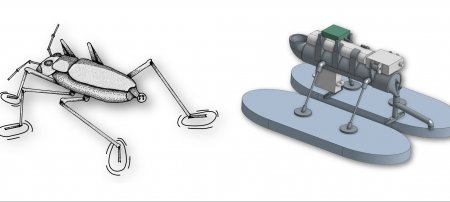It's a fish! It's a bird! No…it's a robot. Inspired by nature, mechanical engineer Nina Mahmoudian is getting underwater robots to move together.
Not only could they travel more easily, but battery charging could be more efficient, too. Charging a robot is the biggest obstacle to underwater missions. That's why Mahmoudian, an assistant professor of mechanical engineering, has grants from both a National Science Foundation (NSF) CAREER Award and the Young Investigator Program (YIP) from the Office of Naval Research to develop strategies to address the problem and advance the system.
In a nutshell, here's what she's doing.
When an autonomous underwater vehicle (AUV, or simply an underwater robot) leaves the ship, it can't stay out for more than matter of hours because it has to circle back and restore its battery life. To be efficient and observe the area of interest efficiently it is better to use multiple AUVs. Now imagine if those robots could leave the ship and a coordinated school of small robots could glide in and recharge them on the fly. That school of fish-like coordination could keep the main robots continuously operating, saving some human time and dollars.
How this strategy plays out in our daily lives is much closer than the ocean floor. For example, Amazon wants to use drones to drop off packages at our doorsteps. Well, in order to find the most efficient route through your neighborhood or recharge drones, those robots have to be coordinated. Mahmoudian's research into continuous operation can help make programs like Prime Air happen.
For more details, check out the live chat with @NinaMahmoudian from this spring.
#NationalRoboticsWeek goes underwater with @NinaMahmoudian & @mturesearch live chat 1-2p today. #mtulive #NSFcareer pic.twitter.com/C0tTHSbJej
— Michigan Tech (@michigantech) April 6, 2016
Let’s get this chat started with @NinaMamoudian! Feel free to post questions and add to the conversation with #roboweek #mtulive
— MTU Research (@mturesearch) April 6, 2016
National Robotics Week
Held during the first full week of April, this annual event brings together a number of students, industry professionals and researchers. Robots can take many different forms and @NinaMahmoudian focuses on underwater robotics.
Why #robotics @NinaMahmoudian? What inspired you study them? #roboweek #mtulive
— MTU Research (@mturesearch) April 6, 2016
@mturesearch Robots are used for explorations in different domains. From Space to depth of ocean and on ground or in air. #mtulive
— Nina Mahmoudian (@NinaMahmoudian) April 6, 2016
@NinaMahmoudian, you work a lot with underwater robotics. Tell us about the big picture of your research #roboweek #mtulive #NSFcareer
— MTU Research (@mturesearch) April 6, 2016
1/4 The goal is to have robots work for longer period of time to gather information. #MTULive #roboweek #NSFcareer
— Nina Mahmoudian (@NinaMahmoudian) April 6, 2016
2/4 The challenges for underwater networks are the battery life and dynamic environment. #MTULive #rbotoweek
— Nina Mahmoudian (@NinaMahmoudian) April 6, 2016
3/4 Energy efficient design, path planning, and using multiple AUVs to explore an area are effective solutions. #MTULive #roboweek
— Nina Mahmoudian (@NinaMahmoudian) April 6, 2016
And here’s a fleet of ROUGHIES. We use them to collect water samples in @LakeSuperior #MTULive #roboweek pic.twitter.com/iAMHq6Ikm1
— Nina Mahmoudian (@NinaMahmoudian) April 6, 2016
4/4 We want to add recharge to operation cycle without human intervention. #MTULive #roboweek
— Nina Mahmoudian (@NinaMahmoudian) April 6, 2016
What Makes a Robot Go
The biggest obstacle with underwater robots right now is battery life. @NinaMahmoudian's goal is to create a reliable fleet of "charging robots" that can swoop in, charge larger underwater vehicles, which will help keep them on their missions longer without needing to circle back for a charge.
Here’s our own research-oriented underwater glider we call ROUGHIE. Here it is being deployed #MTULive #roboweek pic.twitter.com/Bbkozl4Okx
— Nina Mahmoudian (@NinaMahmoudian) April 6, 2016
The drones have limited operational life, so we need to consider both performance and power consumption in the task scheduling. #MTULive
— Nina Mahmoudian (@NinaMahmoudian) April 6, 2016
2/3 We will provide solution for planning operation and recharging cycle of drones. #MTULive #roboweek
— Nina Mahmoudian (@NinaMahmoudian) April 6, 2016
We can optimally place charging stations for the operation area or perform mobile charging when necessary. #MTULive pic.twitter.com/HH4UmNBhBP
— Nina Mahmoudian (@NinaMahmoudian) April 6, 2016
Inspired by Nature
Different animal groups inspire robotic group coordination. For example, fish schools travel in different shapes depending on whether they are looking for food, swimming, or hiding. When they stop to feed, they break the rank, and then they reform to continue traveling.
We want to mimic what we see in nature for mobile sensor networks. This illustration says it all #MTULive #roboweek pic.twitter.com/QnLL1dHugp
— Nina Mahmoudian (@NinaMahmoudian) April 6, 2016
People and Robots
Making fully autonomous vehicles have several benefits for people.
@NinaMahmoudian Why is it important to cut humans out of robot-AUV-drone processes? #roboweek #mtulive
— MTU Research (@mturesearch) April 6, 2016
@mturesearch It causes interruption, energy loss, and there are dangerous situations. #MTULive #roboweek
— Nina Mahmoudian (@NinaMahmoudian) April 6, 2016
We use robots to deliver power for disaster recovery efforts. We work on the foundation necessary for creating a mobile #microgrid #MTULive
— Nina Mahmoudian (@NinaMahmoudian) April 6, 2016
We also have this scaled up version of the #microgrid project with our #Huskieshttps://t.co/MAFVFGAobv #MTUlive https://t.co/PSjTj2XMpT
— NASLab (@NASLabMTU) April 6, 2016
And here is us @NASLabMTU celebrating #roboweek with @NinaMahmoudian @michigantech @UpperPeninsula #mtulive pic.twitter.com/m9Kll1mRg3
— Saide (Donna) (@DonnaFard) April 6, 2016
.@michigantech scientists are building robots to help save lives. #MTULive #roboweek #drones https://t.co/G7Oix37wnG
— Science MI (@sciencemi) April 6, 2016
The Next Generation
@NinaMahmoudian Inspiring students is an important part of your work. How do you encourage #girlsinSTEM? #roboweek #mtulive
— MTU Research (@mturesearch) April 6, 2016
We want to engage young students learning engineering process w/ hands-on activities with GUPPIE #mtulive #roboweek pic.twitter.com/LtJmuohO3V
— Nina Mahmoudian (@NinaMahmoudian) April 6, 2016
@NASLabMTU members and I will be teaching several @MTUSYP robotics classes this summer. #MTULive pic.twitter.com/3Zbj7l8gcv
— Nina Mahmoudian (@NinaMahmoudian) April 6, 2016
@NinaMahmoudian I'm so excited for this summer with @NASLabMTU and @mtusyp #roboweek #mtulive https://t.co/vcCoJHUsCX
— Saide (Donna) (@DonnaFard) April 6, 2016
Looks like a lot of fun learning about robots, engineering, and science in the summer. @mtusyp #mtulive https://t.co/RZ9nCA4Vwo
— NASLab (@NASLabMTU) April 6, 2016
I know we are looking forward to swimming with the GUPPIE and inspiring #STEM https://t.co/MuSGelA7jO #mtulive https://t.co/RZ9nCA4Vwo
— NASLab (@NASLabMTU) April 6, 2016
Michigan Technological University is an R1 public research university founded in 1885 in Houghton, and is home to nearly 7,500 students from more than 60 countries around the world. Consistently ranked among the best universities in the country for return on investment, Michigan's flagship technological university offers more than 120 undergraduate and graduate degree programs in science and technology, engineering, computing, forestry, business, health professions, humanities, mathematics, social sciences, and the arts. The rural campus is situated just miles from Lake Superior in Michigan's Upper Peninsula, offering year-round opportunities for outdoor adventure.






Comments